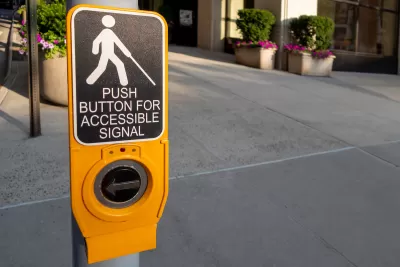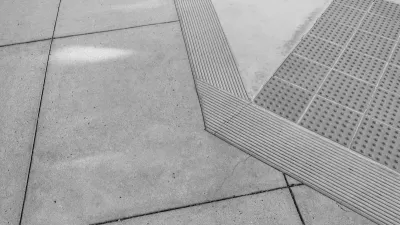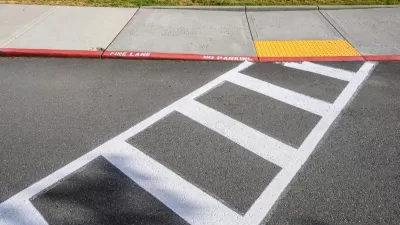The new rules could help bridge the gaps in accessibility infrastructure and ADA compliance, making roads and sidewalks safer for everyone.

Writing in Strong Towns, Ben Abramson asserts that newly approved Americans with Disabilities Act (ADA) and Architectural Barriers Act (ABA) Public Right-of-Way Accessibility Guidelines (PROWAG) “promise to make American towns and cities safer and more predictable for users of all abilities.”
The new guidelines “address access to sidewalks and streets, crosswalks, curb ramps, pedestrian signals, on-street parking, and other components of public rights-of-way,” Abramson adds.
The new PROWAG adds accessibility requirements to pedestrian access routes such as slope, calls for alternate access routes in construction areas, and mandates curb cuts and detectable warning surfaces at crosswalks. It also requires accessible pedestrian signals, “which have audible and vibrotactile features indicating the walk interval so that a pedestrian who is blind or has low vision will know when to cross the street.”
The guidelines also address accessibility at transit stops and accessible parking spaces in neighborhoods with street parking.
For Strong Towns director of community action Edward Erfurt, “the level of detail in the new guidelines is a game changer” that will bring new best practices to cities that have lagged behind in implementing accessibility improvements. “This specificity, and the legal requirement that planners and engineers adhere to the guidelines, promises to bring improvements that will make everyone in American cities safer.”
FULL STORY: New PROWAG Guidelines a Major Advance for ADA (and All Pedestrians)

Study: Maui’s Plan to Convert Vacation Rentals to Long-Term Housing Could Cause Nearly $1 Billion Economic Loss
The plan would reduce visitor accommodation by 25,% resulting in 1,900 jobs lost.

North Texas Transit Leaders Tout Benefits of TOD for Growing Region
At a summit focused on transit-oriented development, policymakers discussed how North Texas’ expanded light rail system can serve as a tool for economic growth.

Why Should We Subsidize Public Transportation?
Many public transit agencies face financial stress due to rising costs, declining fare revenue, and declining subsidies. Transit advocates must provide a strong business case for increasing public transit funding.

How to Make US Trains Faster
Changes to boarding platforms and a switch to electric trains could improve U.S. passenger rail service without the added cost of high-speed rail.

Columbia’s Revitalized ‘Loop’ Is a Hub for Local Entrepreneurs
A focus on small businesses is helping a commercial corridor in Columbia, Missouri thrive.

Invasive Insect Threatens Minnesota’s Ash Forests
The Emerald Ash Borer is a rapidly spreading invasive pest threatening Minnesota’s ash trees, and homeowners are encouraged to plant diverse replacement species, avoid moving ash firewood, and monitor for signs of infestation.
Urban Design for Planners 1: Software Tools
This six-course series explores essential urban design concepts using open source software and equips planners with the tools they need to participate fully in the urban design process.
Planning for Universal Design
Learn the tools for implementing Universal Design in planning regulations.
City of Santa Clarita
Ascent Environmental
Institute for Housing and Urban Development Studies (IHS)
City of Grandview
Harvard GSD Executive Education
Toledo-Lucas County Plan Commissions
Salt Lake City
NYU Wagner Graduate School of Public Service





























